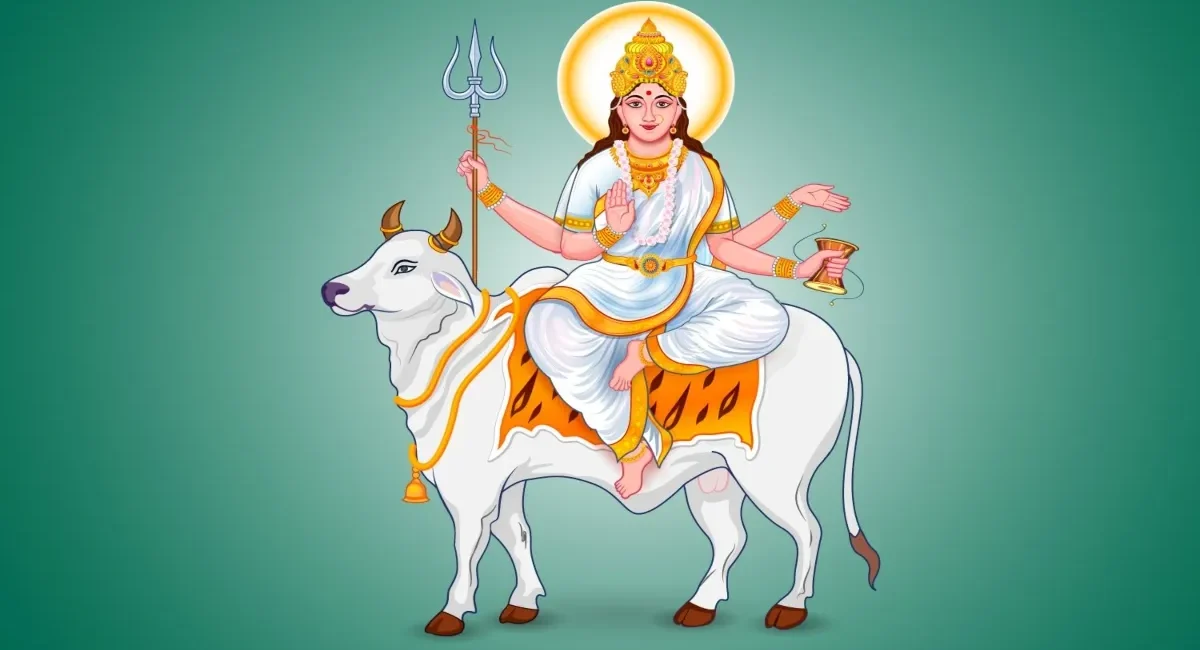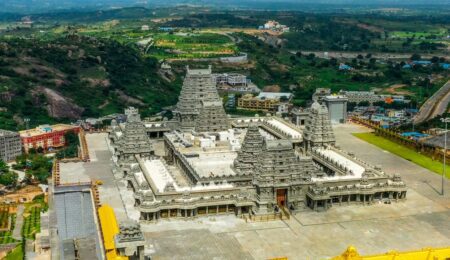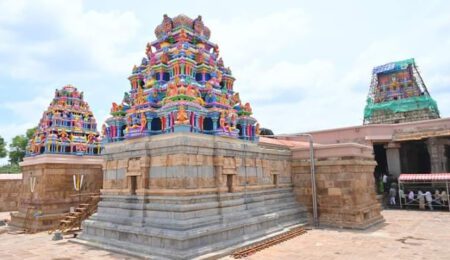Mahagauri – The Eighth Form of Goddess Durga Worshipped on Navratri Day 8
Introduction to Goddess Mahagauri
Mahagauri is the eighth manifestation of Goddess Durga, revered on the eighth day (Ashtami) of Navratri. Her name, appearance, and divine qualities symbolize purity, serenity, and spiritual transformation. Among the Navadurga forms, Mahagauri is considered the most graceful and compassionate, known for her power to absolve sins and grant liberation.
Navratri, the nine-night festival dedicated to the worship of Goddess Durga, celebrates each of her nine forms. On Ashtami, devotees honor Mahagauri with deep devotion, seeking her blessings for peace, prosperity, and spiritual growth. Her worship is especially significant for those seeking purification of the soul and relief from past karmic burdens.
Mahagauri is believed to reside in the Sahasrara Chakra, the crown chakra, which represents the highest level of consciousness. Her energy is said to elevate the devotee’s spiritual awareness and lead them toward enlightenment.
Meaning and Symbolism of the Name ‘Mahagauri’
The name “Mahagauri” is derived from two Sanskrit words: “Maha” meaning great, and “Gauri” meaning fair or white. Together, the name signifies “the one who is extremely fair and radiant.” Her complexion is described as white like the moon, conch shell, or jasmine flower, symbolizing purity and divine brilliance.
In spiritual terms, “Gauri” also represents wisdom, movement, and liberation. She is the embodiment of sattva (purity), and her name evokes the qualities of calmness, forgiveness, and inner light. The whiteness of Mahagauri is not just physical—it reflects the cleansing of the soul and the removal of ignorance.
Her name also connects her to Goddess Parvati, who is often referred to as Gauri in various scriptures. Mahagauri is thus a serene and purified form of Parvati, representing the culmination of spiritual penance and divine grace.
Mythological Background and Birth Story
The story of Mahagauri is deeply rooted in Hindu mythology and the Puranas. According to legend, Goddess Parvati undertook severe penance to win Lord Shiva as her husband. She performed austerities in harsh conditions, which caused her complexion to darken due to dust and exposure.
Pleased by her devotion, Lord Shiva bathed her in the sacred waters of the Ganga. As a result, her dark complexion transformed into a radiant white, and she became known as Mahagauri. This transformation symbolizes the purification of the soul through penance and divine intervention.
Another version of the story appears in the Shiva Purana. It is said that Lord Shiva teasingly called Parvati “Kali” due to her dark skin. Hurt by the comment, Parvati performed intense penance to regain her fair complexion. She bathed in the Mansarovar Lake, and her body turned white and luminous, giving rise to the form of Mahagauri.
Mahagauri also played a significant role in the battle against demons. After assuming fierce forms like Kaushiki and Kalratri to defeat Shumbha, Nishumbha, and Raktabija, she returned to her peaceful Mahagauri form. This transition from fierce to serene highlights the dual nature of the Goddess—both destroyer of evil and bestower of peace.
Appearance and Iconography
Mahagauri is depicted as a beautiful young woman with a radiant white complexion. Her serene expression and graceful posture convey peace and compassion. She is usually shown seated on a white bull, known as Vrishabha, which symbolizes strength, purity, and dharma.
She has four arms, each holding symbolic items:
- In one hand, she holds a trident (Trishul), representing divine power and protection.
- In another, she carries a drum (Damaru), symbolizing cosmic rhythm and creation.
- Her third hand is in the Abhaya Mudra, offering protection and fearlessness.
- The fourth hand is in the Varada Mudra, granting boons and blessings.
She wears a white sari, adorned with minimal ornaments, emphasizing her purity and simplicity. Her calm demeanor and divine aura make her a favorite among devotees seeking peace and spiritual elevation.
Spiritual Significance and Powers
Mahagauri is revered for her ability to purify the soul and remove the accumulated sins of past lives. Her energy is associated with the Sahasrara Chakra, the highest energy center in the human body, which governs spiritual awakening and enlightenment.
Devotees believe that worshipping Mahagauri helps in:
- Cleansing negative karma and emotional baggage
- Attaining inner peace and mental clarity
- Overcoming ego, ignorance, and attachment
- Receiving divine grace and blessings for prosperity
- Enhancing spiritual growth and connection with the divine
Her serene form inspires devotees to embrace simplicity, compassion, and forgiveness. She is also considered the protector of women and children, and her blessings are sought for marital harmony and family well-being.
Connection to Navratri (Day 8) Worship
Mahagauri is worshipped on the eighth day of Navratri, known as Durga Ashtami. This day is considered one of the most auspicious in the nine-day festival. Devotees observe fasts, perform special rituals, and engage in devotional singing and chanting.
The rituals of Ashtami include:
- Kanya Puja: Worship of nine young girls representing the nine forms of Durga
- Sandhi Puja: Performed at the juncture of Ashtami and Navami, symbolizing the transition from fierce to peaceful forms
- Mahasnan: Ritual bathing of the deity’s idol or image
- Offering white flowers, coconut, and sweets to Mahagauri
Devotees wear white or pink clothing on this day, reflecting the purity and grace of the Goddess. Homes and temples are decorated with white flowers, and the atmosphere is filled with devotion and reverence.
Mahagauri Mantra and Their Meanings
Chanting Mahagauri’s mantras is believed to invoke her divine energy and bring peace, prosperity, and spiritual elevation. Below are some powerful mantras dedicated to her:
Beej Mantra
ॐ ऐं ह्रीं क्लीं महागौर्यै नमः॥ Om Aim Hreem Kleem Mahagauryai Namah॥
Meaning: This mantra invokes the divine feminine energy for healing, purification, and spiritual growth.
Dhyan Mantra
वन्दे वाञ्छित कामार्थे चन्द्रार्धकृतशेखराम्। सिंहारूढा चतुर्भुजा महागौरी यशस्विनीम्॥
Meaning: I bow to Mahagauri, who fulfills all desires, wears the crescent moon on her head, rides a lion, and has four arms. She is radiant and glorious.
Benefits of Chanting
- Removes obstacles and negativity
- Enhances mental clarity and emotional balance
- Promotes spiritual awakening and inner peace
- Attracts prosperity, beauty, and harmony
Devotees are encouraged to chant these mantras during Brahma Muhurat (early morning) or during evening prayers for maximum benefit.
Step-by-Step Mahagauri Puja Vidhi
Performing Mahagauri Puja with devotion and proper rituals can bring immense blessings. Below is a detailed guide to the puja process:
Preparation
- Clean the puja space and take a bath
- Wear white or light-colored clothes
- Place Mahagauri’s image or idol on a clean altar
Offerings
- White flowers (especially jasmine)
- Coconut, milk-based sweets, and fruits
- Ghee lamp and incense sticks
Ritual Steps
- Invoke Lord Ganesha to remove obstacles
- Light the lamp and incense
- Chant Mahagauri mantras and offer flowers
- Perform Aarti with devotion
- Conduct Kanya Puja by worshipping nine young girls
- Offer bhog: halwa, puri, and chana
- Distribute prasad and seek blessings
Auspicious Timings
- Brahma Muhurat: 4:30 AM to 6:00 AM
- Sandhya Kaal: 6:00 PM to 7:00 PM
Benefits of Worshipping Mahagauri
Worshipping Mahagauri brings a wide range of benefits—spiritual, emotional, and material.
Spiritual Benefits
- Cleansing of past karmas
- Awakening of Sahasrara Chakra
- Attainment of moksha (liberation)
Emotional Benefits
- Inner peace and emotional stability
- Removal of fear, anxiety, and guilt
- Promotion of forgiveness and compassion
Material Benefits
- Prosperity and abundance
- Marital harmony and family well-being
- Success in personal and professional life
Regional Variations in Worship Across India
Mahagauri is worshipped in different ways across India, reflecting regional customs and traditions.
North India
- Kanya Puja and fasting are common
- Recitation of Durga Saptashati
- Temples decorated with white flowers
East India
- Celebrated as part of Durga Puja
- Elaborate pandals and cultural programs
- Sandhi Puja performed with great devotion
South India
- Gauri Puja and Kumari Puja are performed with traditional rituals
- Women observe fasts and offer turmeric, kumkum, and betel leaves
- Devotional songs and bhajans are sung in praise of Mahagauri
West India
- Garba and Dandiya Raas are popular during Navratri
- Mahagauri is invoked through folk songs and community pujas
- Offerings include coconut, sweets, and white flowers
These regional variations reflect the cultural richness of Mahagauri worship and how her divine presence is honored in diverse ways across the country.
Mahagauri in Art, Literature, and Folk Traditions
Mahagauri has been a prominent figure in Indian art, literature, and folk traditions for centuries. Her serene form and divine attributes have inspired countless artists, poets, and performers.
In Art
- Traditional paintings like Madhubani, Patachitra, and Warli depict Mahagauri with intricate designs and symbolic elements
- Sculptures in temples often show her seated on a bull, holding her divine weapons
- Modern artists portray her in minimalist styles to emphasize her purity and grace
In Literature
- Bhakti poets like Meera Bai, Tulsidas, and Surdas have composed verses in her praise
- Scriptures such as the Devi Mahatmya and Shiva Purana describe her origin and powers
- Her name appears in various hymns and stotras dedicated to the Goddess
In Folk Traditions
- Folk songs and dances during Navratri often include references to Mahagauri
- Local legends and stories highlight her role in protecting villages and granting boons
- Community rituals and storytelling sessions keep her legacy alive in rural areas
Mahagauri’s presence in cultural expressions reinforces her role as a nurturing and transformative force in the lives of devotees.
Modern-Day Relevance of Mahagauri Worship
In today’s fast-paced and stressful world, Mahagauri’s worship offers a path to inner peace and spiritual clarity. Her qualities of forgiveness, purity, and compassion are more relevant than ever.
Spiritual Detox
- Her worship encourages self-reflection and emotional cleansing
- Helps individuals reconnect with their higher self and purpose
Women’s Empowerment
- Mahagauri symbolizes feminine strength and grace
- Inspires women to embrace their inner power and wisdom
Adaptation of Traditions
- Online pujas and virtual satsangs make her worship accessible to all
- Eco-friendly rituals promote sustainability and respect for nature
- Community service and charity during Navratri reflect her compassionate spirit
Mahagauri’s worship is evolving with time, yet her essence remains unchanged—she continues to guide devotees toward light, truth, and liberation.
Common Mistakes to Avoid in Mahagauri Puja
While Mahagauri Puja is simple and devotional, certain mistakes can reduce its effectiveness. Beginners should be mindful of the following:
- Using stale or inappropriate offerings – Always use fresh flowers, fruits, and sweets.
- Neglecting cleanliness – The puja space and personal hygiene are crucial.
- Incorrect mantra pronunciation – Learn the correct intonation or follow a trusted source.
- Skipping Kanya Puja – This is an essential part of Ashtami rituals.
- Rushing through the puja – Perform each step with devotion and mindfulness.
- Ignoring auspicious timings – Follow Brahma Muhurat or Sandhya Kaal for best results.
- Disrespecting the rituals – Approach the puja with sincerity and reverence.
Avoiding these mistakes ensures that the worship is spiritually fulfilling and aligned with tradition.
FAQs About Mahagauri
- Who is Mahagauri? Mahagauri is the eighth form of Goddess Durga, symbolizing purity, peace, and spiritual transformation.
- Why is Mahagauri worshipped on Ashtami? Ashtami marks her divine transformation and victory over darkness, making it an auspicious day for her worship.
- What is Mahagauri’s vehicle? She rides a white bull named Vrishabha, symbolizing strength and dharma.
- Which chakra is associated with Mahagauri? The Sahasrara Chakra, representing the highest level of consciousness and spiritual awakening.
- What color is worn on Mahagauri’s day? White or light pink, reflecting purity and serenity.
- What are the benefits of Mahagauri Puja? Spiritual cleansing, emotional healing, prosperity, and inner peace.
- Can men perform Kanya Puja? Yes, with devotion and respect, men can perform Kanya Puja.
- Is fasting mandatory on Ashtami? Fasting is recommended but not mandatory; devotion is key.
- What is the best time to perform Mahagauri Puja? Brahma Muhurat (early morning) or Sandhya Kaal (evening) are ideal.
- How many times should the Mahagauri mantra be chanted? Ideally 108 times using a rosary (japa mala), but even fewer repetitions with devotion are beneficial.
Conclusion
Mahagauri, the eighth form of Goddess Durga, embodies divine purity, grace, and transformation. Her worship on Navratri Ashtami is a sacred opportunity to cleanse the soul, seek forgiveness, and elevate one’s spiritual consciousness. Through her serene presence, devotees are reminded of the power of devotion, the beauty of simplicity, and the promise of liberation.
Whether through traditional rituals, mantras, or modern adaptations, Mahagauri continues to inspire and bless those who seek her with a pure heart. Her divine role in the Navadurga pantheon is not just symbolic it is a living force that guides humanity toward light, truth, and eternal peace.




Leave a Comment